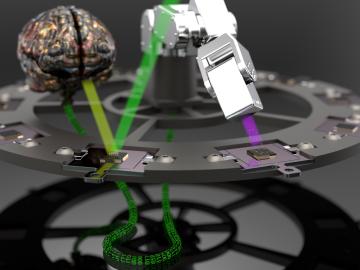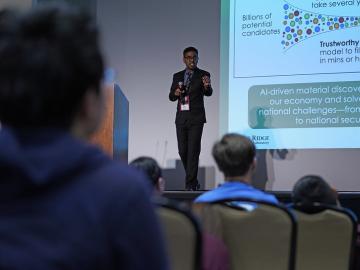
Filter News
Area of Research
News Topics
- 3-D Printing/Advanced Manufacturing (1)
- Artificial Intelligence (27)
- Big Data (1)
- Bioenergy (2)
- Biology (4)
- Biomedical (4)
- Chemical Sciences (2)
- Climate Change (2)
- Computer Science (15)
- Coronavirus (1)
- Decarbonization (1)
- Exascale Computing (2)
- Fossil Energy (1)
- Frontier (4)
- Grid (1)
- High-Performance Computing (5)
- Machine Learning (7)
- Materials Science (2)
- Mathematics (1)
- Microscopy (1)
- Nanotechnology (1)
- National Security (3)
- Net Zero (1)
- Neutron Science (2)
- Security (1)
- Simulation (1)
- Summit (3)
- Sustainable Energy (2)
- Transformational Challenge Reactor (1)
Media Contacts

Researchers at the Department of Energy’s Oak Ridge National Laboratory and partner institutions have launched a project to develop an innovative suite of tools that will employ machine learning algorithms for more effective cybersecurity analysis of the U.S. power grid.

Oak Ridge National Laboratory scientists have developed a method leveraging artificial intelligence to accelerate the identification of environmentally friendly solvents for industrial carbon capture, biomass processing, rechargeable batteries and other applications.

Today, scientific discovery is accelerated by automated experiments, artificial intelligence and high-performance computing. A novel tool developed at ORNL that leverages those technologies has demonstrated that AI can influence materials synthesis and conduct associated experiments without human supervision.

Prasanna Balaprakash, a national leader in artificial intelligence, or AI, spoke to some of the highest achieving students in the country at the National Science Bowl in Washington D.C.

A team led by researchers at ORNL explored training strategies for one of the largest artificial intelligence models to date with help from the world’s fastest supercomputer. The findings could help guide training for a new generation of AI models for scientific research.

Researchers at the Department of Energy’s Oak Ridge National Laboratory met recently at an AI Summit to better understand threats surrounding artificial intelligence. The event was part of ORNL’s mission to shape the future of safe and secure AI systems charged with our nation’s most precious data.

Groundbreaking report provides ambitious framework for accelerating clean energy deployment while minimizing risks and costs in the face of climate change.
Luke Bertels, a Eugene P. Wigner Fellow, is helping determine ways to combine artificial intelligence and quantum computing, specifically to develop classical and quantum machine learning methods for using adaptive neural networks to study correlated molecules and chemical systems.

In partnership with the National Cancer Institute, researchers from the Department of Energy’s Oak Ridge National Laboratory’s Modeling Outcomes for Surveillance using Scalable Artificial Intelligence are building on their groundbreaking work to

In summer 2023, ORNL's Prasanna Balaprakash was invited to speak at a roundtable discussion focused on the importance of academic artificial intelligence research and development hosted by the White House Office of Science and Technology Policy and the U.S. National Science Foundation.


